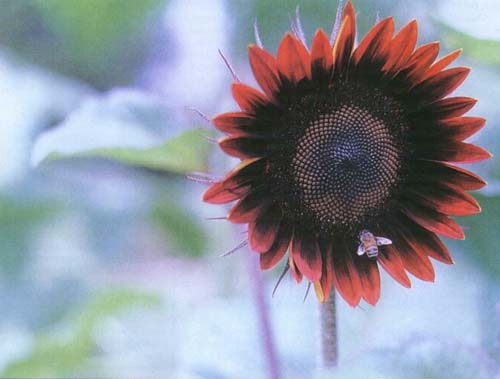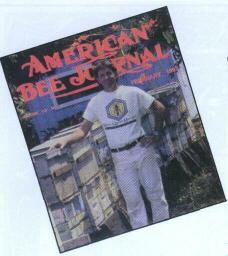 |
Home | Search | Browse | About IPO | Staff | Links |
 |
Home | Search | Browse | About IPO | Staff | Links |
|

That is the question for many specialty crop growers, especially melon and fruit growers, whose crops must be pollinated by bees. If you'll excuse the punning, the answer could be: That's because two parasitic mites are causing a significant decline in bees internationally. A few years ago it was estimated there were about 250,000 beekeepers in the United States, managing more than 4 million colonies. "A year ago, though, there were reports around the country and even in the Midwest, of severe colony loses. Some states claimed 80 to 90 percent colony losses. Here in Illinois we were estimating maybe 40 to 60 percent," said Scott Frank, who oversees the state Department of Agriculture's apiary inspection program. All beekeepers are required to be registered with his office, and as of Jan. 1 there were 4,181 beekeepers registered in Illinois. "Some beekeepers didn't lose anything. Some beekeepers lost everything they had," said Frank. The problem is significant because about one-third of all the food we eat is dependant upon bees and other insects for pollination. The U.S. Department of Agriculture has estimated about 3.5 million U.S. acres of fruits, vegetables, oilseeds and legume seed crops depend on insect pollination. Another 63 million acres benefit from insect pollination. About 80 percent of crop insect pollination is accomplished by honey bees, and a 1989 Cornell University study estimated the direct value of honey bee pollination to U.S. agriculture at about $9.7 billion. The culprits are the Varroa mite and the tracheal mite, both introduced accidentally into the U.S. about a decade ago. Varroa mites are visible to the human eye (about the size of a pinhead) and attach themselves to the bees, where they suck on its life juices, weakening and killing them. The tracheal mite, which is microscopic, gets into the breathing tubes of the APRIL 1997 ILLINOIS COUNTRY LIVING 9 honey bee and literally suffocates it. Only one product, Apistan strips, has been approved by the federal Environmental Protection Agency to control the Varroa mite. These strips have a pesticide called flauvinate embedded in them and the strips are inserted into the hive in the fall after the honey is harvested. The tracheal mite may be controlled in one of two ways. One is the use of menthol crystals. The other is with grease patties, which are a combination of vegetable shortening mixed with sugar. "The bees feed on that and get some of the oil also. It's been shown long-term treatment with these grease patties has controlled tracheal mites," Frank said. "There are a lot of benefits to beekeeping. Some people just enjoy it. For some, it's helping nature. Although you think of stings when you think of bees, they aren't really all that likely to sting unless they're provoked or unless beekeepers mess with the nest and aren't careful or gentle around them," he said. There is little benefit to field crops, Frank said. That's because corn is cross-pollinated by the wind and soybeans are self pollinated, although he said studies show a slight yield improvement when honey bees helped pollinate soybeans. However, some specialty crop growers would greatly improve yields if they kept bees nearby. Cucumbers, melon, pumpkin and squash depend almost 100 percent on various insects for pollination (required for a fruit, vegetable or nut to develop). Those crops' dependence specifically upon honey bees is very high: for cucumbers, 90 percent; melons, 80 percent; pumpkins and squash about 60 percent, said Frank. Most commercial growers must rent colonies, sometimes from commercial beekeepers who often travel from state to state, moving from south to north as the seasons change. There are only a handful of commercial beekeepers in Illinois; the vast majority keep only a few hives and do it mostly for the honey, or to pollinate their own crops, not to make money.
Frank keeps only one colony because, he said, "I like the honey." His bees also help pollinate a garden of approximately two acres. Rita Taylor, of Pleasant Plains, is one of the bee inspectors who report to Frank. It's a job her husband, Hoyt, had until his death 15 years ago. Beekeeping was his occupation during the 1930s, taking him all over the Midwest on marketing trips. Taylor now farms 120 acres of corn and soybeans. Also upon her husband's death, she assumed his post as secretary-treasurer of the Illinois State Beekeepers Association, which has about 450 members. Taylor, a member of Menard Electric Cooperative, now farms 120 acres of corn and soybeans, and keeps six hives of honey bees, which pollinate her five apple trees. She harvested about 200 pounds of honey last year, despite a late harvest. She said she knows of other beekeepers whose honey yields were even higher. As a result of the mite infestation, honey prices have risen, Taylor said, now fetching about $2 a pound. Roy West of Pawnee keeps about 25 hives in his young apple orchard of about 30 trees on eight acres. Thus far, his bees and trees have produced more pleasure than profit. "In the last four years I've averaged $10 a year on beekeeping," he said. "It's not really a profit making thing, unless you get into it real big. I guess I do it because there's not many people doing it," he said "I enjoy doing it. It's fascinating." —Story by Janeen Keener
Long before humans learned to refine sugar, honey was the first sweetener—treasured, and reserved for the rich, because it was available only in large quantities and was the only sweetner available. In fact, taxes often were paid in honey.
Honey is a mixture of sugars, mostly glucose and fructose, and contains small amounts of the B vitamins riboflavin, pantothenic acid, thiamin, nicotinic acid and pyridoxine. Small amounts of vitamin C also are present, and honey provides many minerals, including potassium, chlorine, sulfur, calcium, sodium, phosphorous, magnesium, silica, silican, iron, manganese, copper and several trace elements. Honey also provides acids and enymes the body needs. Honey is available in many different colors and flavors, depending on the type of flowers from which the honey bees gathered nectar. Clover honey is popular, because of its lovely amber color and mild, aromatic flavor. Other varieties include those derived from alfalfa, citrus or orange blossoms, buckwheat, aster, basswood or linden trees, goldenrod, dandelions, sage, cotton, and soybeans. Honey may be substituted in almost any recipe and provides excellent results because it retains moisture; foods made with it stay moist and fresh longer. The rule of thumb is to substitute 3/4 cup of honey for one cup of sugar up to one cup. Reduce the total amount of other liquids in the recipe by 1/4 cup per cup of honey. Lower baking temperatures by 25 degrees F. to avoid overbrowning.
A collection of more than 100 low-fat honey recipes, entitled Sweetened Naturally with Honey, send $2.95 to the National Honey Board, Dept. NPR, PO Box l25, Wisconsin Rapids, WI 54495, or visit its web page at: http:// www.nhb.org.
10 ILLINOIS COUNTRY LIVING APRIL 1997

The world's largest beekeeping supply business is headquartered in Hamilton, according to Joe Graham, editor of the American Bee Journal, which also is published there as a subsidiary of the business, Dadant & Sons. The 134-year-old business maintains four manufacturing plants and 11 branches around the United States. It was begun in 1863 by Charles Dadant after a failed attempt at growing grapes for wine production, and remains in the Dadant family, Graham said. Graham said Dadant & Sons provides everything a beekeeper needs except the bees. The mite infestation "has hurt our business because beekeepers have lost probably over a million colony of bees in the last ten years to both of these mites together." That means many hobbyists have simply quit, or have been forced to buy replacement bees and to buy the treatments to kill the mites instead of buying more equipment. The monthly magazine was begun in 1861 and purchased by the Dadant family in 1912. Graham, who is a member of Western Illinois Electric Coop., keeps about 20 colonies himself. "I almost have to keep bees if I'm the editor of the magazine," he quipped. Subscriptions are available for $17.95 a year. Write the American Bee Journal at 51 S. Second Street, Hamilton, IL 62341, or call him at (217) 847-3324. Or send $2 to join the Illinois State Beekeepers Association at Route 2, Box 249, Pleasant Plains, IL 62677, and get a reduced rate on the American Bee Journal and other bee publications. APRIL 1997 ILLINOIS COUNTRY LIVING 11 |
|
|